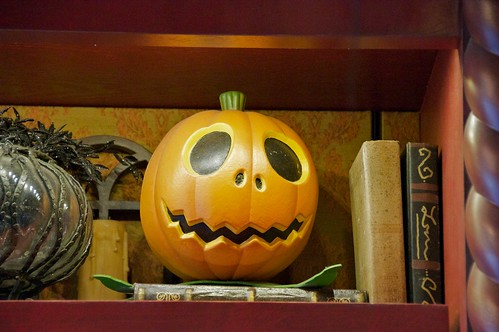We were not disappointed - it's a true landmark...
Note about parking: it's expensive, so make sure you go to their website for details of where to park and how to get a validation discount. (Read this carefully - you have to apply for a library card - if you don't already have one - in order to get validation. It's free to residents of LA, Orange, and Ventura Counties, but be prepared to wait in line.)
Finally out of the parking structure, we approached the steps, fountains, and entryway in the McGuire Garden...
These elements comprise Jud Fine’s major art program, “Spine”, and feature inscriptions and sculptures symbolizing an open book. Flanking this Flower Street entrance to the gardens are two pieces not unlike the frontispiece or end sheets of a book. Looking ahead is a series of stairs past raised pools titled “Bright,” “Lucid,” and “Clear.”
Risers on the steps on either side of the fountains encompass a slightly patina brass finish with letters from 19 languages etched in green; black copper plate with printed words in nine languages cut into the surface in white; and symbolic communications in higher math, art and poetry established during the electron age, etched on stainless steel plate in black.
Source: To learn more, look HERE and also check out the library website's page, "Art & Architecture in Central Library".
 |
| Entrance off Flower Street, "WISDOM OF THE EAST AND WEST" |
Once inside the library, we went to the Tom Bradley Wing...it was built after two arson fires in 1986 damaged the building and destroyed 20% of the Library’s books. Many of the surviving books suffered smoke and water damage.
Mayor Tom Bradley and Lodwrick Cook, then CEO of the oil company ARCO, co-chaired the $10 million fund-raising drive to repair and replace the books that were damaged or destroyed. Their “Save the Books” campaign is commemorated with the renaming of the main rotunda for Cook, and the modern wing for Mayor Bradley.
 The escalators and walkways at each level provide different perspectives on the atrium, and on three chandeliers decorated with a rather enigmatic collection of objects and figures.
The escalators and walkways at each level provide different perspectives on the atrium, and on three chandeliers decorated with a rather enigmatic collection of objects and figures.  On each of the three landings on the atrium’s lower floors is an Illumination, a “functional sculpture” by Anne Preston. These four-meter-high lanterns refer to “light, understanding, and books.” They’re circular arrays of aluminum vanes, the top of which is shaped like an upside-down human profile.
On each of the three landings on the atrium’s lower floors is an Illumination, a “functional sculpture” by Anne Preston. These four-meter-high lanterns refer to “light, understanding, and books.” They’re circular arrays of aluminum vanes, the top of which is shaped like an upside-down human profile. We moved on to the Rotunda, which houses the Children's Literature Department. As we entered, we were surrounded with beautiful murals by Dean Cornwell...depicting four great eras of California history, including discovery, mission building, Americanization and the founding of Los Angeles. They were completed in 1932.
 |
| "Americanization" |
THE CHILDREN'S LITERATURE DEPARTMENT, "A Library within a Library"!
The first thing we noticed was a feeling of calm, as our eyes were met with inviting wooden tables and chairs, low lighting, and green carpet - patterned in a nature motif, with images like this cute bushy-tailed squirrel.
My favorite area was, of course, the picture book room, at the far end of the department!
So. Many. Lovely. Books.
Several of the tables had baskets full of board books for toddlers.
On the library website, I had noted there would be an International Language Picture Book Collection - "A historic collection of over 5,000 titles from more than 50 countries. We had fun digging up all the HARRY POTTER books we could find in different languages...
 |
| Korean |
 |
| Russian |
 |
| Vietnamese |
 |
| French (had my favorite illustrations) |
 |
| German (gotta love the glasses!) |
 |
| To us it seemed like this book opened backwards, but not when you read the pages right to left! |
 |
| Japanese |
Time to leave the library...
at Philppe's on Alameda Street (it's been there since 1908!) Established by Philippe Mathieu, who claimed the distinction of having created the "French Dipped Sandwich."
 |
| Placing our order at the counter. |
 |
| These are the prices, folks! |
 |
| Yes, a cup of coffee is 9 cents. (The price remained a nickel until 1977.) |
 |
| French onion soup. (We also got a home-made doughnut - for 70 cents - to go with the 9 cent cup of coffee my daughter ordered.) |
Bye, bye! (Seems kind of weird that young adults my daughter's age consider telephone booths with pay phones to be vintage. I must be getting old!)


















































